HAT304 - Tech Advances & Trends in Gastronomy & Food Tourism
VerifiedAdded on 2023/06/07
|8
|1309
|236
Essay
AI Summary
This essay examines the contemporary issues in the hospitality and tourism industry, focusing on gastronomic tourism and food trends. It analyzes the impact of technological advancements, such as digital marketing, social media, and molecular gastronomy, on gastronomic tourism. The essay also explores how these advancements influence new food trends and consumer behavior, referencing examples like drone-based food service and the increasing popularity of diverse cuisines through social media. The analysis covers both positive and negative effects, highlighting the changing landscape of food tourism due to technology. Desklib provides a platform to access similar solved assignments and study resources for students.
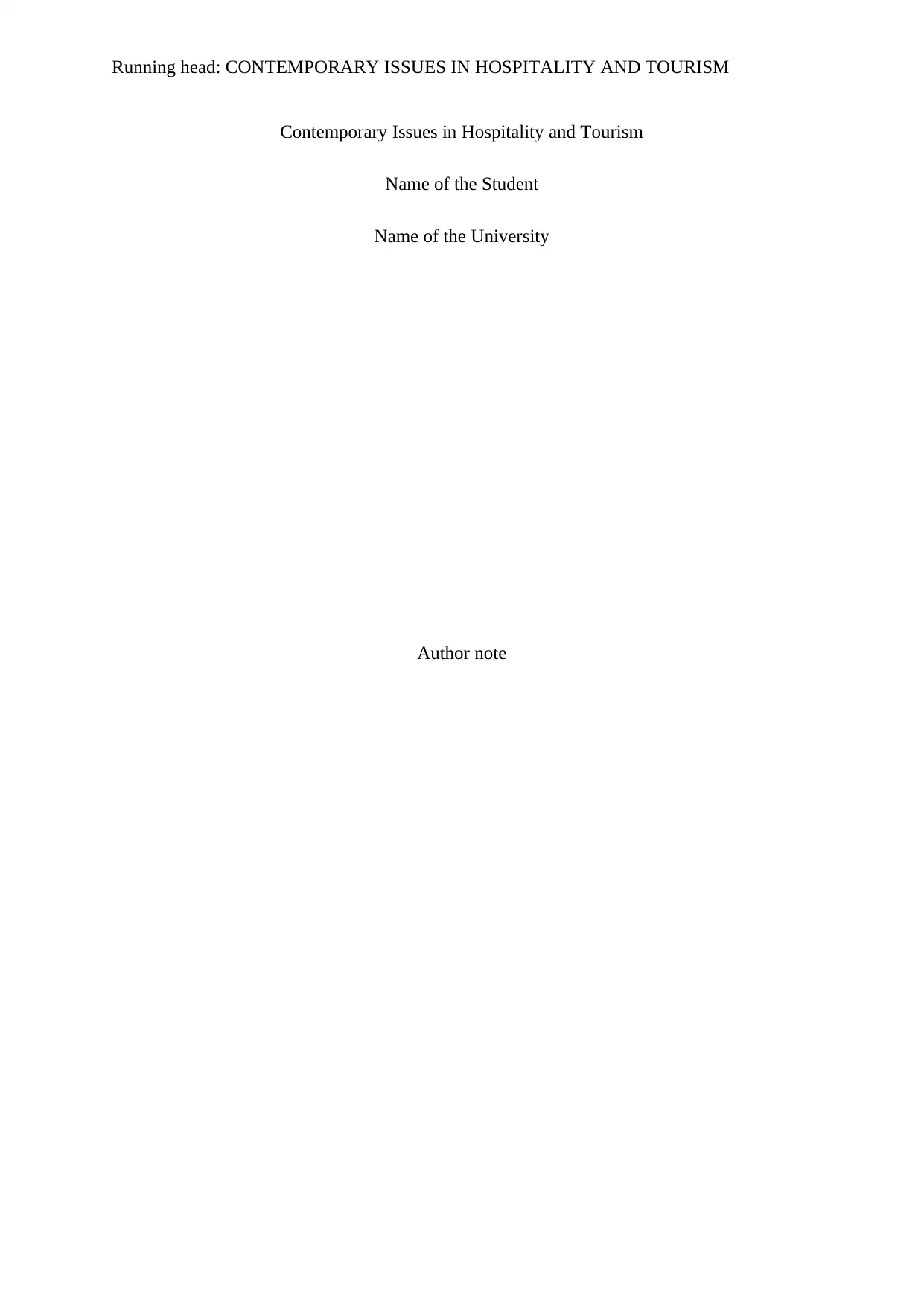
Running head: CONTEMPORARY ISSUES IN HOSPITALITY AND TOURISM
Contemporary Issues in Hospitality and Tourism
Name of the Student
Name of the University
Author note
Contemporary Issues in Hospitality and Tourism
Name of the Student
Name of the University
Author note
Paraphrase This Document
Need a fresh take? Get an instant paraphrase of this document with our AI Paraphraser
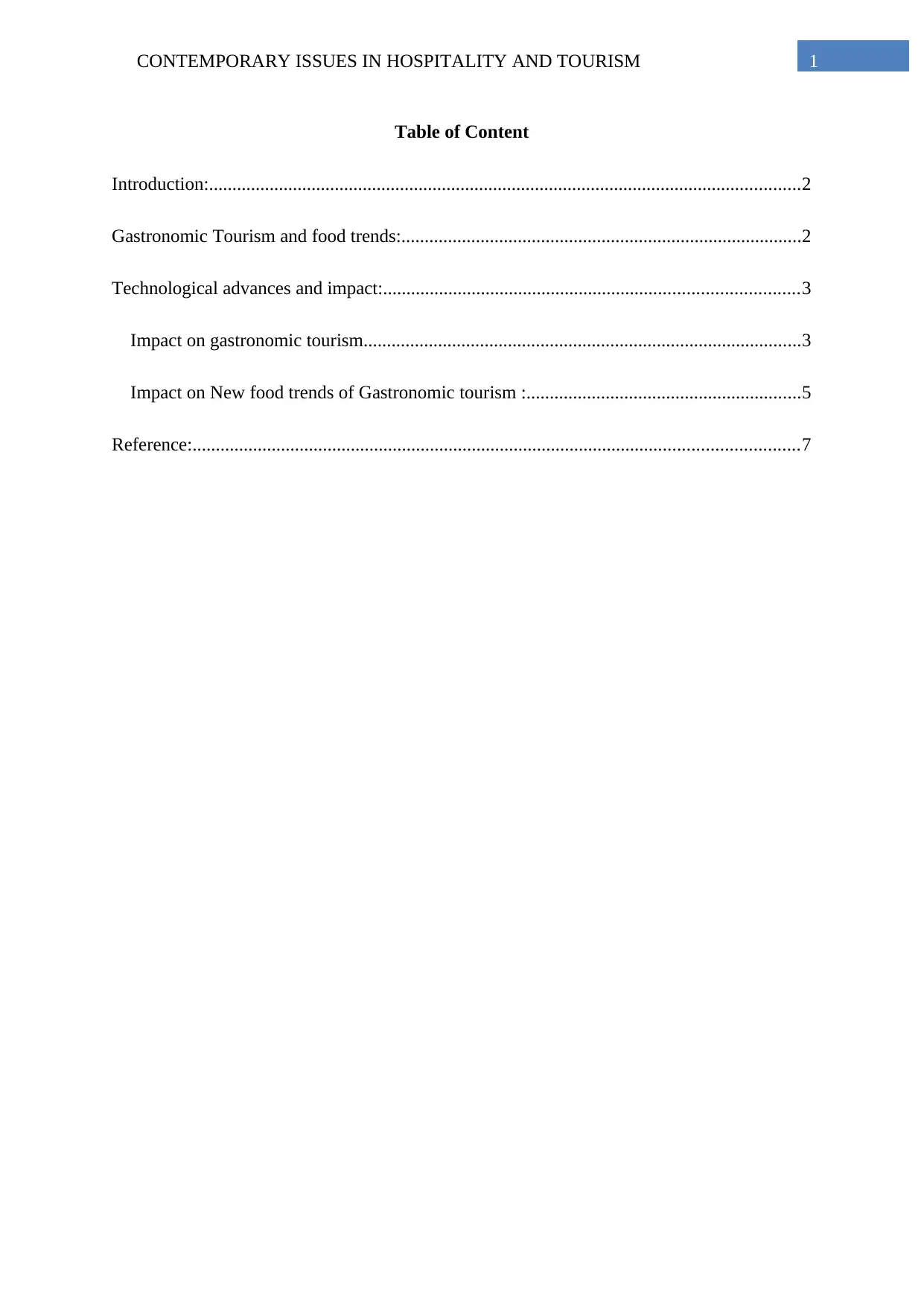
1CONTEMPORARY ISSUES IN HOSPITALITY AND TOURISM
Table of Content
Introduction:...............................................................................................................................2
Gastronomic Tourism and food trends:......................................................................................2
Technological advances and impact:.........................................................................................3
Impact on gastronomic tourism..............................................................................................3
Impact on New food trends of Gastronomic tourism :...........................................................5
Reference:..................................................................................................................................7
Table of Content
Introduction:...............................................................................................................................2
Gastronomic Tourism and food trends:......................................................................................2
Technological advances and impact:.........................................................................................3
Impact on gastronomic tourism..............................................................................................3
Impact on New food trends of Gastronomic tourism :...........................................................5
Reference:..................................................................................................................................7
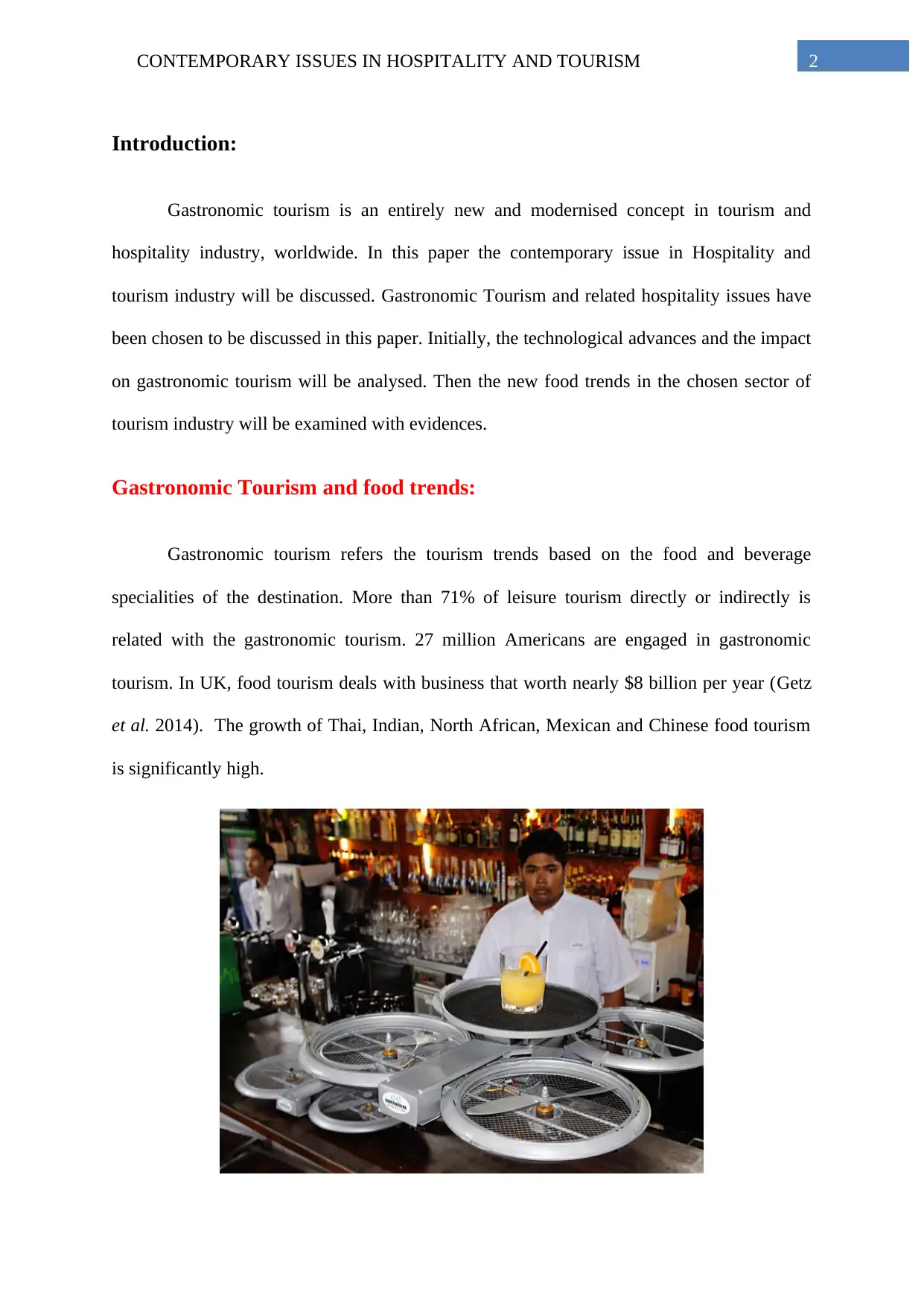
2CONTEMPORARY ISSUES IN HOSPITALITY AND TOURISM
Introduction:
Gastronomic tourism is an entirely new and modernised concept in tourism and
hospitality industry, worldwide. In this paper the contemporary issue in Hospitality and
tourism industry will be discussed. Gastronomic Tourism and related hospitality issues have
been chosen to be discussed in this paper. Initially, the technological advances and the impact
on gastronomic tourism will be analysed. Then the new food trends in the chosen sector of
tourism industry will be examined with evidences.
Gastronomic Tourism and food trends:
Gastronomic tourism refers the tourism trends based on the food and beverage
specialities of the destination. More than 71% of leisure tourism directly or indirectly is
related with the gastronomic tourism. 27 million Americans are engaged in gastronomic
tourism. In UK, food tourism deals with business that worth nearly $8 billion per year (Getz
et al. 2014). The growth of Thai, Indian, North African, Mexican and Chinese food tourism
is significantly high.
Introduction:
Gastronomic tourism is an entirely new and modernised concept in tourism and
hospitality industry, worldwide. In this paper the contemporary issue in Hospitality and
tourism industry will be discussed. Gastronomic Tourism and related hospitality issues have
been chosen to be discussed in this paper. Initially, the technological advances and the impact
on gastronomic tourism will be analysed. Then the new food trends in the chosen sector of
tourism industry will be examined with evidences.
Gastronomic Tourism and food trends:
Gastronomic tourism refers the tourism trends based on the food and beverage
specialities of the destination. More than 71% of leisure tourism directly or indirectly is
related with the gastronomic tourism. 27 million Americans are engaged in gastronomic
tourism. In UK, food tourism deals with business that worth nearly $8 billion per year (Getz
et al. 2014). The growth of Thai, Indian, North African, Mexican and Chinese food tourism
is significantly high.
⊘ This is a preview!⊘
Do you want full access?
Subscribe today to unlock all pages.

Trusted by 1+ million students worldwide
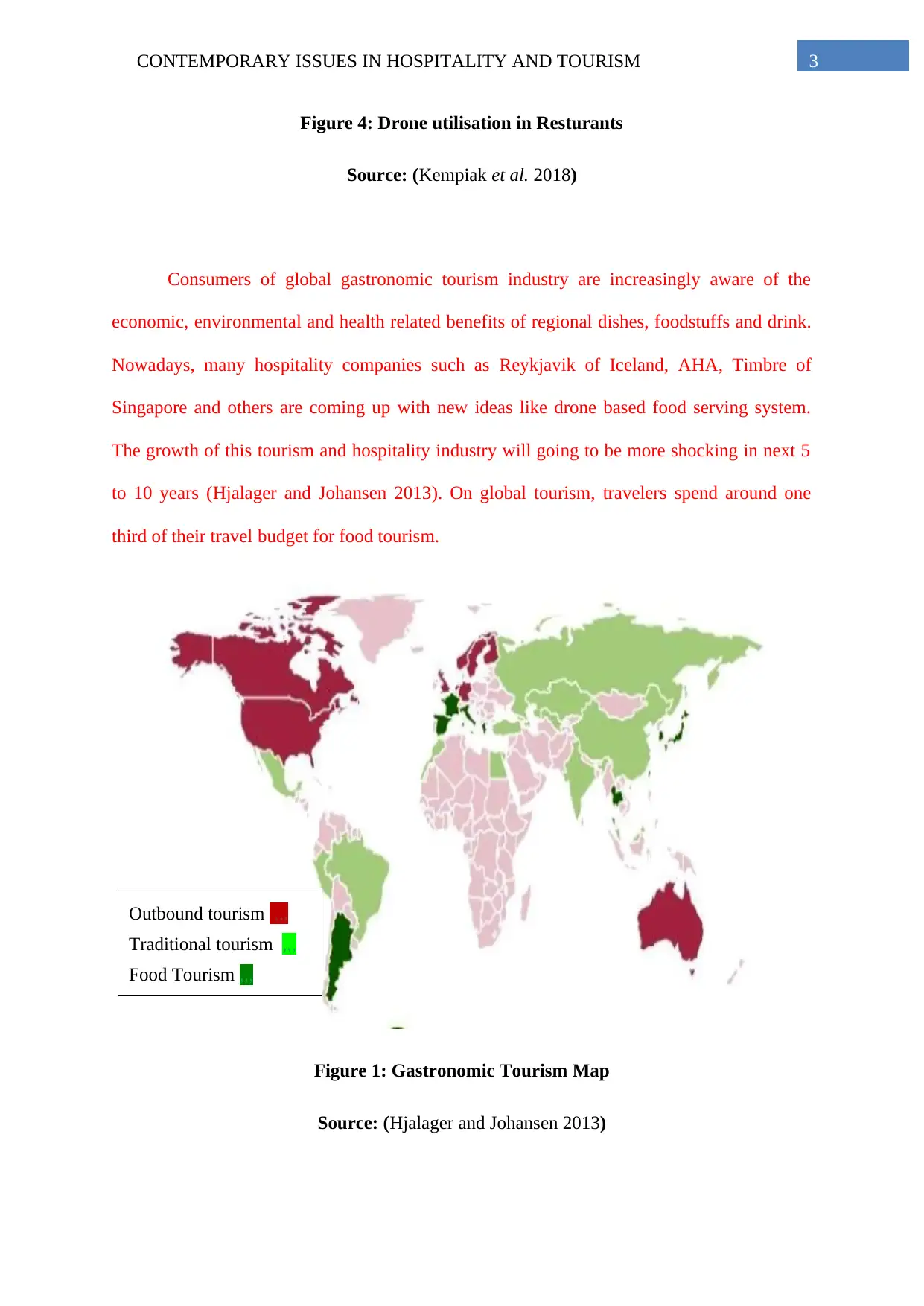
3CONTEMPORARY ISSUES IN HOSPITALITY AND TOURISM
Figure 4: Drone utilisation in Resturants
Source: (Kempiak et al. 2018)
Consumers of global gastronomic tourism industry are increasingly aware of the
economic, environmental and health related benefits of regional dishes, foodstuffs and drink.
Nowadays, many hospitality companies such as Reykjavik of Iceland, AHA, Timbre of
Singapore and others are coming up with new ideas like drone based food serving system.
The growth of this tourism and hospitality industry will going to be more shocking in next 5
to 10 years (Hjalager and Johansen 2013). On global tourism, travelers spend around one
third of their travel budget for food tourism.
Figure 1: Gastronomic Tourism Map
Source: (Hjalager and Johansen 2013)
Outbound tourism ,,,
Traditional tourism ,,,
Food Tourism ,,,
Figure 4: Drone utilisation in Resturants
Source: (Kempiak et al. 2018)
Consumers of global gastronomic tourism industry are increasingly aware of the
economic, environmental and health related benefits of regional dishes, foodstuffs and drink.
Nowadays, many hospitality companies such as Reykjavik of Iceland, AHA, Timbre of
Singapore and others are coming up with new ideas like drone based food serving system.
The growth of this tourism and hospitality industry will going to be more shocking in next 5
to 10 years (Hjalager and Johansen 2013). On global tourism, travelers spend around one
third of their travel budget for food tourism.
Figure 1: Gastronomic Tourism Map
Source: (Hjalager and Johansen 2013)
Outbound tourism ,,,
Traditional tourism ,,,
Food Tourism ,,,
Paraphrase This Document
Need a fresh take? Get an instant paraphrase of this document with our AI Paraphraser
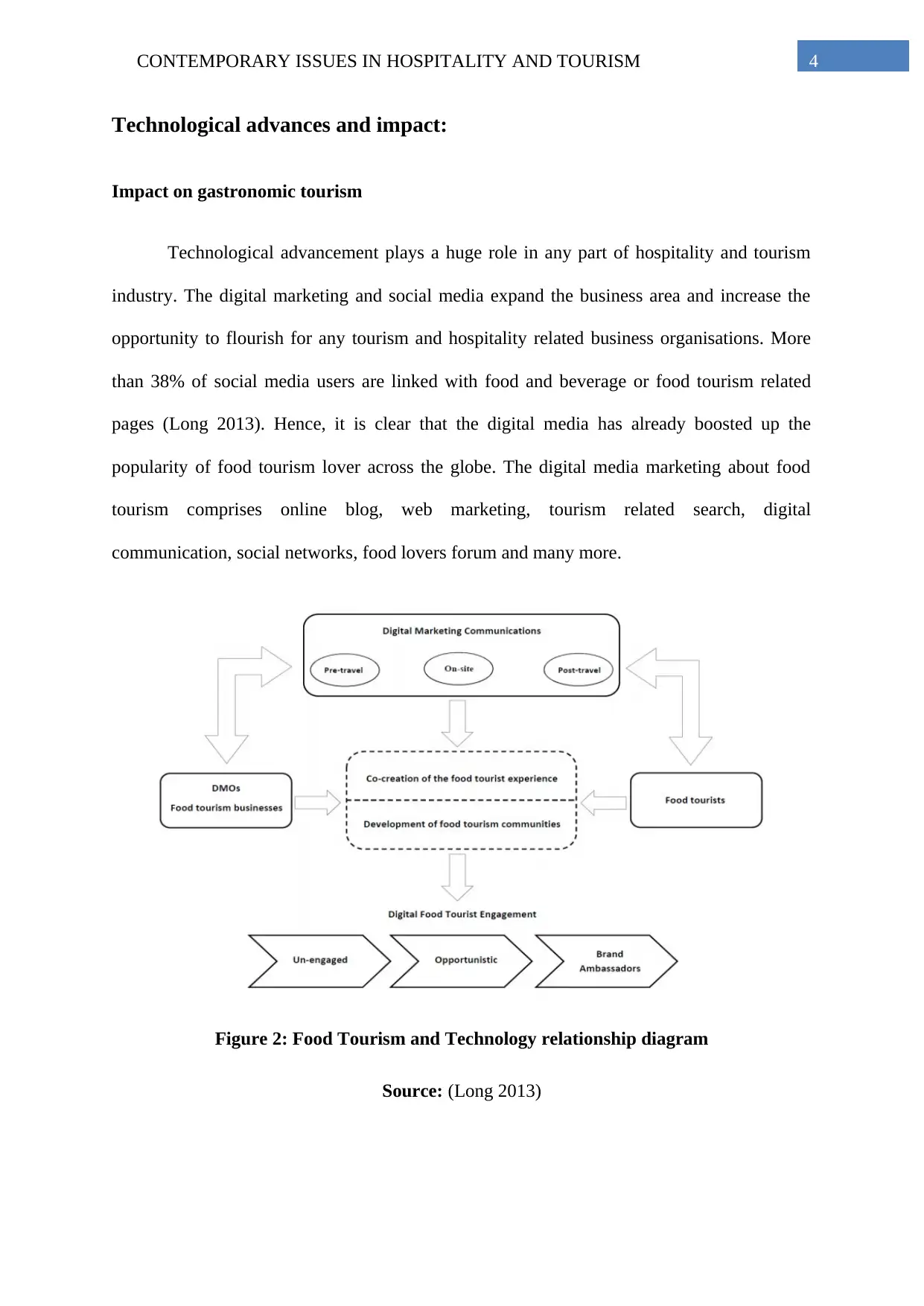
4CONTEMPORARY ISSUES IN HOSPITALITY AND TOURISM
Technological advances and impact:
Impact on gastronomic tourism
Technological advancement plays a huge role in any part of hospitality and tourism
industry. The digital marketing and social media expand the business area and increase the
opportunity to flourish for any tourism and hospitality related business organisations. More
than 38% of social media users are linked with food and beverage or food tourism related
pages (Long 2013). Hence, it is clear that the digital media has already boosted up the
popularity of food tourism lover across the globe. The digital media marketing about food
tourism comprises online blog, web marketing, tourism related search, digital
communication, social networks, food lovers forum and many more.
Figure 2: Food Tourism and Technology relationship diagram
Source: (Long 2013)
Technological advances and impact:
Impact on gastronomic tourism
Technological advancement plays a huge role in any part of hospitality and tourism
industry. The digital marketing and social media expand the business area and increase the
opportunity to flourish for any tourism and hospitality related business organisations. More
than 38% of social media users are linked with food and beverage or food tourism related
pages (Long 2013). Hence, it is clear that the digital media has already boosted up the
popularity of food tourism lover across the globe. The digital media marketing about food
tourism comprises online blog, web marketing, tourism related search, digital
communication, social networks, food lovers forum and many more.
Figure 2: Food Tourism and Technology relationship diagram
Source: (Long 2013)
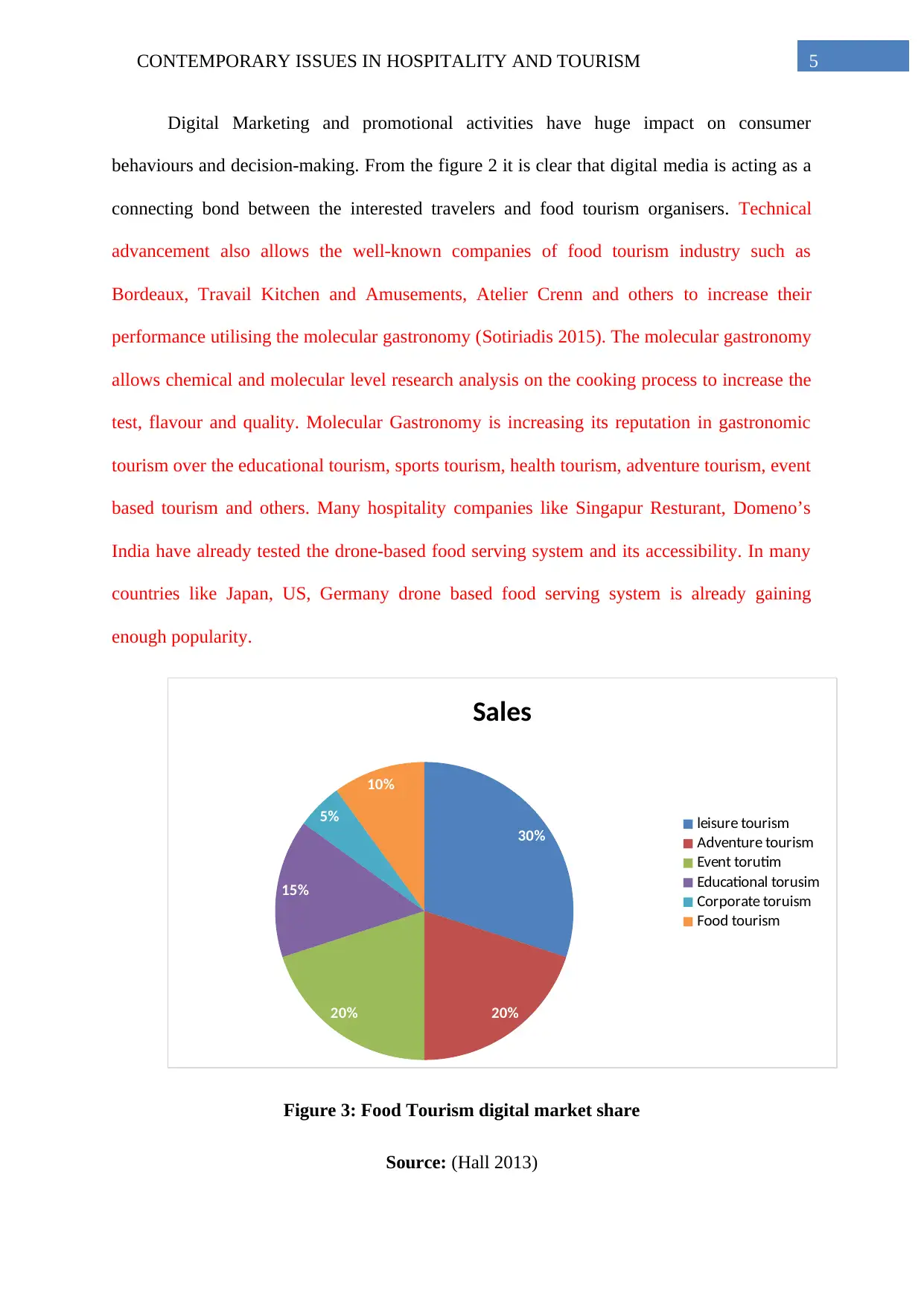
5CONTEMPORARY ISSUES IN HOSPITALITY AND TOURISM
Digital Marketing and promotional activities have huge impact on consumer
behaviours and decision-making. From the figure 2 it is clear that digital media is acting as a
connecting bond between the interested travelers and food tourism organisers. Technical
advancement also allows the well-known companies of food tourism industry such as
Bordeaux, Travail Kitchen and Amusements, Atelier Crenn and others to increase their
performance utilising the molecular gastronomy (Sotiriadis 2015). The molecular gastronomy
allows chemical and molecular level research analysis on the cooking process to increase the
test, flavour and quality. Molecular Gastronomy is increasing its reputation in gastronomic
tourism over the educational tourism, sports tourism, health tourism, adventure tourism, event
based tourism and others. Many hospitality companies like Singapur Resturant, Domeno’s
India have already tested the drone-based food serving system and its accessibility. In many
countries like Japan, US, Germany drone based food serving system is already gaining
enough popularity.
30%
20%20%
15%
5%
10%
Sales
leisure tourism
Adventure tourism
Event torutim
Educational torusim
Corporate toruism
Food tourism
Figure 3: Food Tourism digital market share
Source: (Hall 2013)
Digital Marketing and promotional activities have huge impact on consumer
behaviours and decision-making. From the figure 2 it is clear that digital media is acting as a
connecting bond between the interested travelers and food tourism organisers. Technical
advancement also allows the well-known companies of food tourism industry such as
Bordeaux, Travail Kitchen and Amusements, Atelier Crenn and others to increase their
performance utilising the molecular gastronomy (Sotiriadis 2015). The molecular gastronomy
allows chemical and molecular level research analysis on the cooking process to increase the
test, flavour and quality. Molecular Gastronomy is increasing its reputation in gastronomic
tourism over the educational tourism, sports tourism, health tourism, adventure tourism, event
based tourism and others. Many hospitality companies like Singapur Resturant, Domeno’s
India have already tested the drone-based food serving system and its accessibility. In many
countries like Japan, US, Germany drone based food serving system is already gaining
enough popularity.
30%
20%20%
15%
5%
10%
Sales
leisure tourism
Adventure tourism
Event torutim
Educational torusim
Corporate toruism
Food tourism
Figure 3: Food Tourism digital market share
Source: (Hall 2013)
⊘ This is a preview!⊘
Do you want full access?
Subscribe today to unlock all pages.

Trusted by 1+ million students worldwide
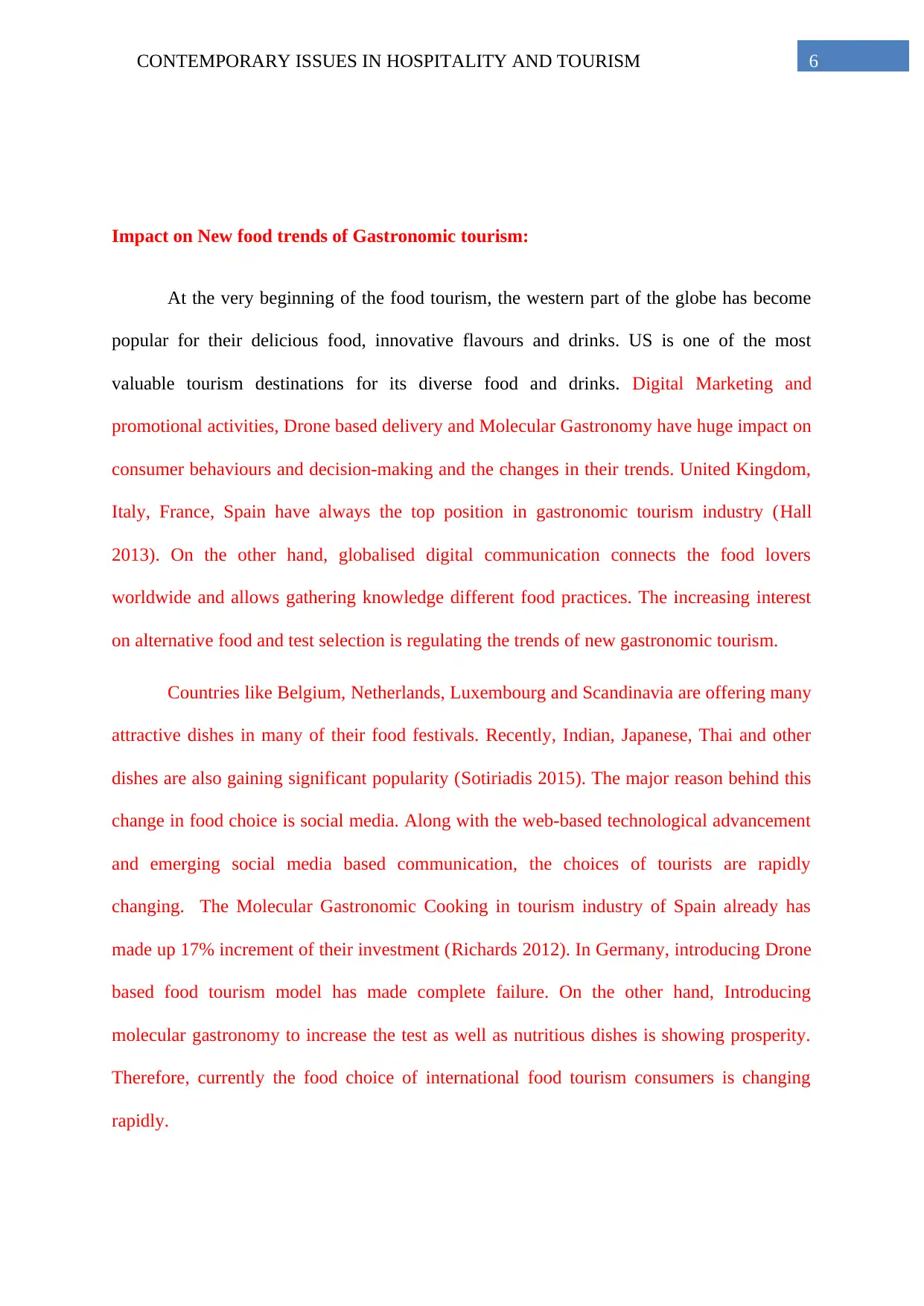
6CONTEMPORARY ISSUES IN HOSPITALITY AND TOURISM
Impact on New food trends of Gastronomic tourism:
At the very beginning of the food tourism, the western part of the globe has become
popular for their delicious food, innovative flavours and drinks. US is one of the most
valuable tourism destinations for its diverse food and drinks. Digital Marketing and
promotional activities, Drone based delivery and Molecular Gastronomy have huge impact on
consumer behaviours and decision-making and the changes in their trends. United Kingdom,
Italy, France, Spain have always the top position in gastronomic tourism industry (Hall
2013). On the other hand, globalised digital communication connects the food lovers
worldwide and allows gathering knowledge different food practices. The increasing interest
on alternative food and test selection is regulating the trends of new gastronomic tourism.
Countries like Belgium, Netherlands, Luxembourg and Scandinavia are offering many
attractive dishes in many of their food festivals. Recently, Indian, Japanese, Thai and other
dishes are also gaining significant popularity (Sotiriadis 2015). The major reason behind this
change in food choice is social media. Along with the web-based technological advancement
and emerging social media based communication, the choices of tourists are rapidly
changing. The Molecular Gastronomic Cooking in tourism industry of Spain already has
made up 17% increment of their investment (Richards 2012). In Germany, introducing Drone
based food tourism model has made complete failure. On the other hand, Introducing
molecular gastronomy to increase the test as well as nutritious dishes is showing prosperity.
Therefore, currently the food choice of international food tourism consumers is changing
rapidly.
Impact on New food trends of Gastronomic tourism:
At the very beginning of the food tourism, the western part of the globe has become
popular for their delicious food, innovative flavours and drinks. US is one of the most
valuable tourism destinations for its diverse food and drinks. Digital Marketing and
promotional activities, Drone based delivery and Molecular Gastronomy have huge impact on
consumer behaviours and decision-making and the changes in their trends. United Kingdom,
Italy, France, Spain have always the top position in gastronomic tourism industry (Hall
2013). On the other hand, globalised digital communication connects the food lovers
worldwide and allows gathering knowledge different food practices. The increasing interest
on alternative food and test selection is regulating the trends of new gastronomic tourism.
Countries like Belgium, Netherlands, Luxembourg and Scandinavia are offering many
attractive dishes in many of their food festivals. Recently, Indian, Japanese, Thai and other
dishes are also gaining significant popularity (Sotiriadis 2015). The major reason behind this
change in food choice is social media. Along with the web-based technological advancement
and emerging social media based communication, the choices of tourists are rapidly
changing. The Molecular Gastronomic Cooking in tourism industry of Spain already has
made up 17% increment of their investment (Richards 2012). In Germany, introducing Drone
based food tourism model has made complete failure. On the other hand, Introducing
molecular gastronomy to increase the test as well as nutritious dishes is showing prosperity.
Therefore, currently the food choice of international food tourism consumers is changing
rapidly.
Paraphrase This Document
Need a fresh take? Get an instant paraphrase of this document with our AI Paraphraser
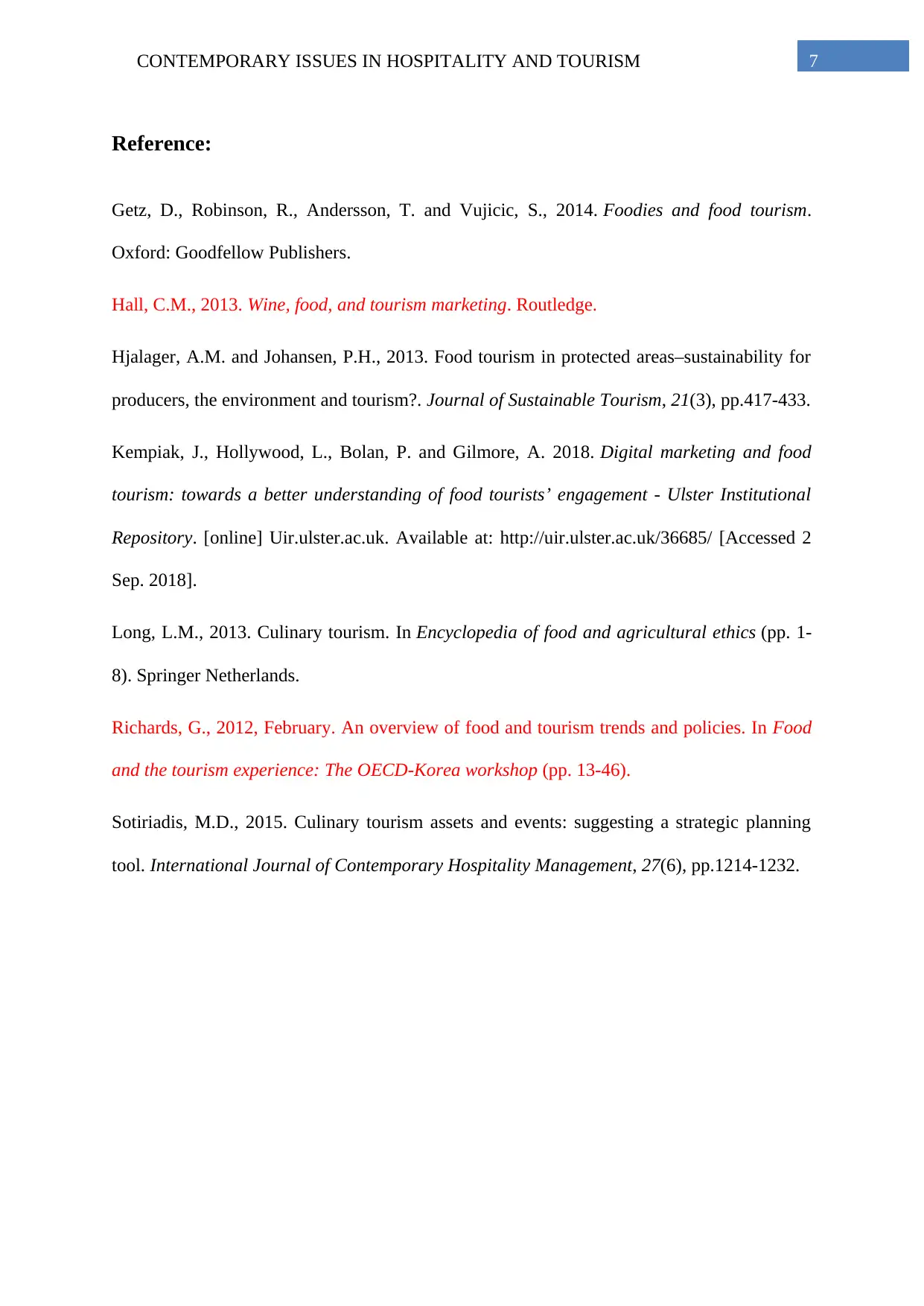
7CONTEMPORARY ISSUES IN HOSPITALITY AND TOURISM
Reference:
Getz, D., Robinson, R., Andersson, T. and Vujicic, S., 2014. Foodies and food tourism.
Oxford: Goodfellow Publishers.
Hall, C.M., 2013. Wine, food, and tourism marketing. Routledge.
Hjalager, A.M. and Johansen, P.H., 2013. Food tourism in protected areas–sustainability for
producers, the environment and tourism?. Journal of Sustainable Tourism, 21(3), pp.417-433.
Kempiak, J., Hollywood, L., Bolan, P. and Gilmore, A. 2018. Digital marketing and food
tourism: towards a better understanding of food tourists’ engagement - Ulster Institutional
Repository. [online] Uir.ulster.ac.uk. Available at: http://uir.ulster.ac.uk/36685/ [Accessed 2
Sep. 2018].
Long, L.M., 2013. Culinary tourism. In Encyclopedia of food and agricultural ethics (pp. 1-
8). Springer Netherlands.
Richards, G., 2012, February. An overview of food and tourism trends and policies. In Food
and the tourism experience: The OECD-Korea workshop (pp. 13-46).
Sotiriadis, M.D., 2015. Culinary tourism assets and events: suggesting a strategic planning
tool. International Journal of Contemporary Hospitality Management, 27(6), pp.1214-1232.
Reference:
Getz, D., Robinson, R., Andersson, T. and Vujicic, S., 2014. Foodies and food tourism.
Oxford: Goodfellow Publishers.
Hall, C.M., 2013. Wine, food, and tourism marketing. Routledge.
Hjalager, A.M. and Johansen, P.H., 2013. Food tourism in protected areas–sustainability for
producers, the environment and tourism?. Journal of Sustainable Tourism, 21(3), pp.417-433.
Kempiak, J., Hollywood, L., Bolan, P. and Gilmore, A. 2018. Digital marketing and food
tourism: towards a better understanding of food tourists’ engagement - Ulster Institutional
Repository. [online] Uir.ulster.ac.uk. Available at: http://uir.ulster.ac.uk/36685/ [Accessed 2
Sep. 2018].
Long, L.M., 2013. Culinary tourism. In Encyclopedia of food and agricultural ethics (pp. 1-
8). Springer Netherlands.
Richards, G., 2012, February. An overview of food and tourism trends and policies. In Food
and the tourism experience: The OECD-Korea workshop (pp. 13-46).
Sotiriadis, M.D., 2015. Culinary tourism assets and events: suggesting a strategic planning
tool. International Journal of Contemporary Hospitality Management, 27(6), pp.1214-1232.
1 out of 8
Related Documents
Your All-in-One AI-Powered Toolkit for Academic Success.
+13062052269
info@desklib.com
Available 24*7 on WhatsApp / Email
![[object Object]](/_next/static/media/star-bottom.7253800d.svg)
Unlock your academic potential
Copyright © 2020–2025 A2Z Services. All Rights Reserved. Developed and managed by ZUCOL.





